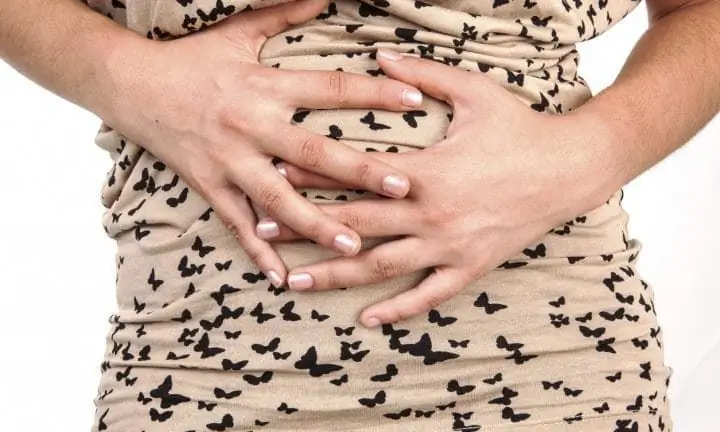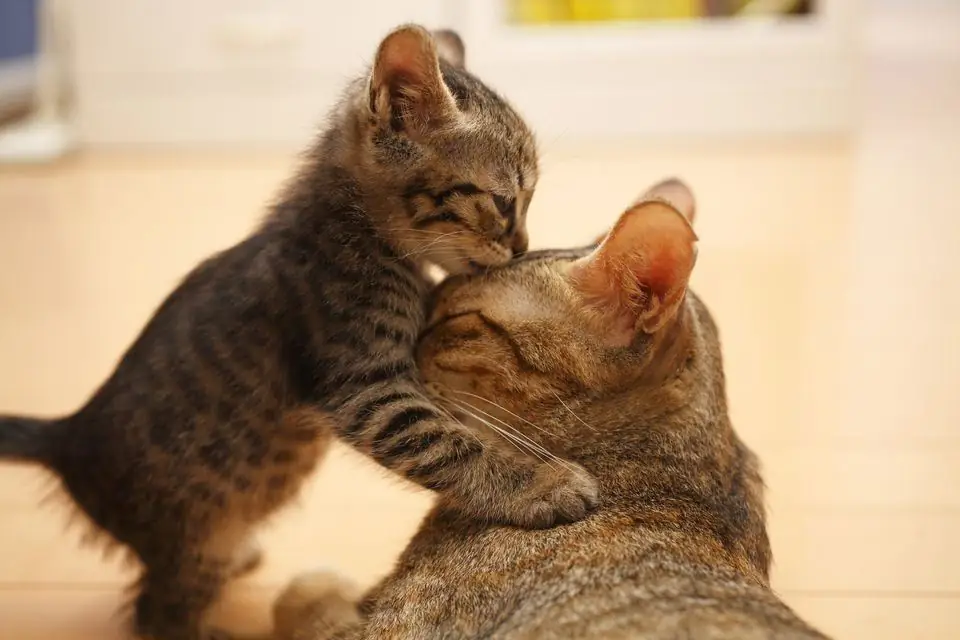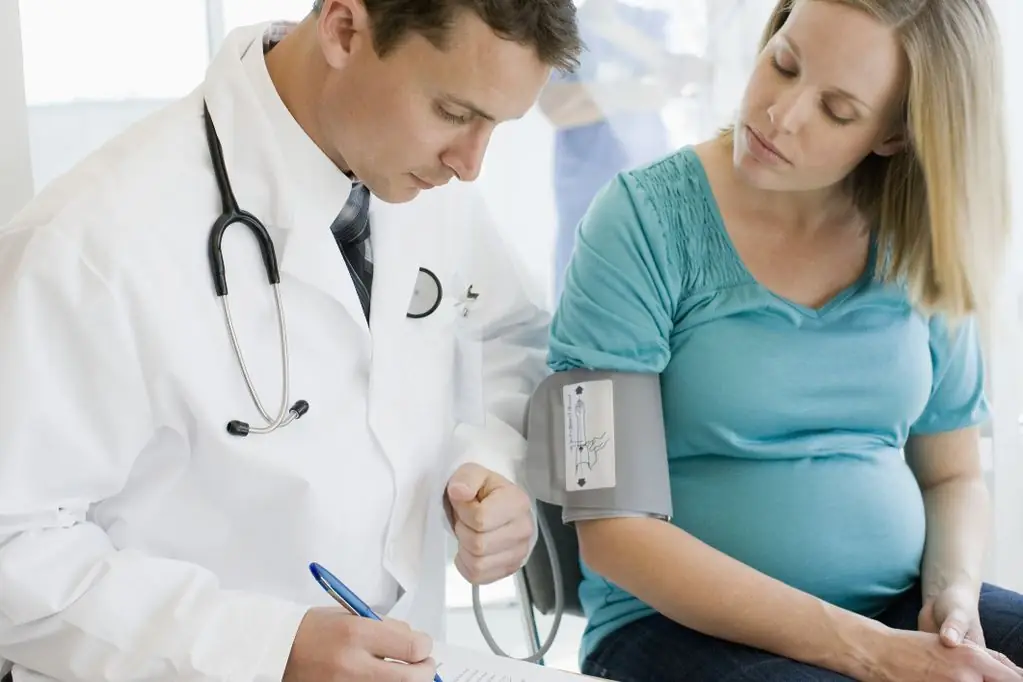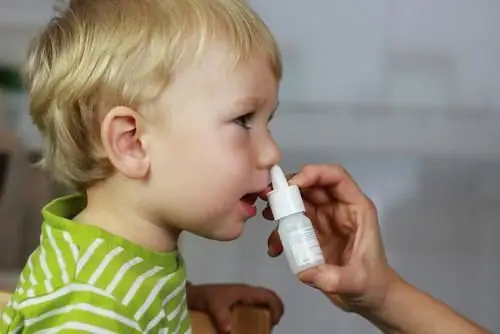2026 Author: Priscilla Miln | [email protected]. Last modified: 2025-01-22 17:55:16
The widespread use of Naphthyzinum is due to its instant action. After instillation, there is a narrowing of the vessels of the nose, the elimination of hyperemia, swelling, exudation of the mucous membrane. The patient feels better after 30 minutes.
Prescribing the drug
Short-acting drug for topical use only. Drops are used for sinusitis, rhinitis, pharyngitis, inflammation of the auditory tube, and also as a prophylactic after surgical interventions in the nose.

Features of taking "Naphthizin"
The uncontrolled use of Naphthyzinum is a common phenomenon. The low cost and over-the-counter sale in pharmacies are helping to increase the number of people using the drops.
With a common cold, many parents are in no hurry to seek medical help, independently determining the medicine, as well as the dosing regimen. This may result in a strongerpoisoning, and in some cases death. The use of 10 ml of a 0.1% solution is considered a lethal dose for a child. It should be remembered that all medicines are potentially dangerous if combined and dosed incorrectly.
Clinical picture of poisoning
Poisoning with Naphthyzinum is a pathological condition caused by an overdose of the drug, individual intolerance to its main active ingredient, use of a drug of inadequate quality or expired. As a rule, it is accompanied by characteristic symptoms, combining both signs of typical intoxication and manifestations inherent in naphazoline.
The clinical picture and symptoms of an overdose of Naphthyzinum are the same in all age groups. But it should be borne in mind that the child's nervous system is not able to cope with overload, so small patients suffer several times more. With a significant excess of the dose, the effect of the solution on the human body has similar features with the effect of clonidine.

Stages of poisoning and their signs
In case of an overdose of Naphthyzinum in children, 3 stages of poisoning are distinguished, which have their own characteristics:
- Easy. An unreasonably frivolous attitude to the use of Naphthyzinum does not allow parents to suspect that it is he who is the cause of the deterioration of the child's condition. This is the main danger. The first symptoms of an overdose of Naphthyzinum in children are taken asmanifestations of the disease, and the use of drops continues. Children fall asleep, while the duration of sleep is longer than usual. Weakness, lethargy, pallor of the skin, a sharp decrease in appetite, slight bradycardia are noted. Hospitalization in this case is not required. Unpleasant symptoms disappear after the drug is completely discontinued.
- Average. Requires the intervention of medical professionals to avoid deterioration of vital signs. The body is covered with cold sweat, and the temperature drops to 36 degrees and below. The child's heartbeat is disturbed, blood pressure drops, the pupils constrict, but continue to respond to light. There is a complete refusal to eat, nausea, vomiting, convulsive syndrome.
- Heavy. With this form of overdose, the central nervous system is depressed. Against the background of respiratory and cardiovascular insufficiency, pulmonary edema develops, the child falls into a coma. The pulse and pressure drops to critical levels, cyanosis appears in some areas of the skin, numbness of the extremities is noted. There are pauses in the work of the heart lasting more than 2 seconds. In the absence of urgent measures, there is a high probability of developing irreversible consequences for the body. If the child is in serious condition, the emergency team will take him to the nearest intensive care unit. Currently, deaths from an overdose of Naphthyzinum have been reported among children who accidentally drank the drug from vials.
Each child is individual, so others may join the above symptoms. AtIf any symptoms of intoxication are detected, medical attention should be sought immediately. Refusal of hospitalization is not allowed.

First aid
In all cases, after an overdose, you must stop taking Naphthyzin, call an ambulance and monitor the child's condition. Self-treatment of poisoning can lead to serious consequences. The decision on hospitalization is made only by the doctor.
When providing first aid for an overdose of Naphthyzinum in children, it is important to correctly assess the general condition, measure the pulse and temperature. All indicators should be recorded. The victim must not be left unattended. The child must remain conscious until the ambulance arrives, for this it is necessary to constantly talk with the victim. It should be put on the bed, covered with a warm blanket and calmed down. Milk should not be given. It will contribute to a faster penetration of the drug into the circulatory system.

Overdose by oral medication
Treatment for an overdose of "Naphthyzinum" in children as a result of its ingestion should begin with gastric lavage. To do this, the child should drink several glasses of warm water and provoke vomiting by irritating the root of the tongue. It is strictly forbidden to use potassium permanganate. The procedure is repeated several times, and only if the child is conscious. After washing is completed, absorbent agents should be taken, for example,activated carbon at the rate of 1 tablet per 10 kilograms of weight. Inducing vomiting is useless if more than 30 minutes have passed since ingestion.
In case of loss of consciousness, it is necessary to monitor the pulse and breathing before the ambulance arrives. When they stop, the only way to save life is chest compressions and mechanical ventilation.

Features of treatment
Treatment of a patient poisoned by nasal drops begins with intravenous atropine sulfate. Upon arrival at the hospital, the patient takes a biochemical blood test to determine the degree of intoxication. An electrocardiogram is mandatory. The course of treatment averages from 1 to 3 days. The patient is discharged after full recovery of normal he alth.
Symptomatic therapy is selected, depending on the clinical picture. Gastric lavage in the hospital is performed using a special gastric tube. To cleanse the blood, Polysorb or Neosmectin is prescribed. With a severe degree of poisoning, glucocorticosteroid hormones cannot be dispensed with. In most cases, the prognosis is favorable. The components of the drug are quickly excreted from the body.
Remember, in case of an overdose of Naphthyzinum in children, the symptoms and treatment of which can only be accurately determined by a doctor, you must definitely call an ambulance.

Prevention of poisoning
Over the past three years, the number of poisonings with Naphthyzinumincreased by 30%. According to statistics, the largest number of victims was recorded in the age group from 1 to 3 years. The timely reaction of relatives and qualified medical assistance helps to save children even if Naphthyzin is swallowed. But it is much easier to prevent poisoning than to treat its consequences. When using vasoconstrictor drops, the following rules should be followed:
- Treatment of nasal congestion should begin with a consultation with a doctor who will select the optimal dosage and duration of therapy. The percentage of the solution should correspond to the age of the child. Drops of 0.025 - 0.05% are acceptable for use. It is strictly forbidden to bury the drug in infants. A negative reaction may appear even after a single application.
- Be sure to study the packaging, paying special attention to the expiration date. An expired product should be thrown away immediately. Parental negligence can cost a child's life. The shelf life cannot exceed 3 years from the date of production. However, it is better to play it safe and not use the drug a month before it ends.
- Increasing the dose does not affect the effectiveness of the drug, but, on the contrary, is harmful to the body.
- Carefully study the instructions. Do not instill the drug more than once every 6-8 hours.
- Use a pipette. Inconvenient plastic packaging often results in over 5 times the instillation. It is especially easy to miss an overdose if the child is self-administering the medication. All manipulations should be carried out onlyparents.
- Do not store Naphthyzin in places accessible to children. All medicines should be put away in special cases on the top shelves.
- Alternate remedy with other vasoconstrictor drops. Instead of instillation, Naphthyzin can be used as lotions. To do this, cotton swabs are soaked in a solution of 0.05% and placed in each nostril for 2 minutes.
Contraindications when taking Naphthyzinum
Be sure to read the column of contraindications to taking the drug in the instructions. Contraindications include: diabetes mellitus, angle-closure glaucoma, atrophic rhinitis, individual intolerance.
Pregnant women and mothers with breastfed children are also strictly prohibited from using the drug in the treatment of the common cold.

Be careful
"Naphthyzine" is a toxic drug, it should be prescribed only by a doctor, and the course of treatment cannot exceed 7 days. It should be remembered that this remedy does not cure the disease, but only helps temporarily relieve unpleasant symptoms. A dangerous side effect of the drug is a quick addiction to it. Pediatricians recommend using safer and more effective analogues for the treatment of a common cold in children.
Recently, the problem of poisoning with vasoconstrictor drops is relevant, as the number of incidents is constantly growing. Many parents don't even realize the danger. Therefore, doctors insist on wide coverage of this problem in the media.
Recommended:
Beginning miscarriage: signs, symptoms, first aid

According to statistics, every fifth pregnancy ends in a miscarriage. There are many reasons why the fetus dies both in early and late pregnancy. Consider how to understand that a miscarriage has begun, how doctors diagnose it, what the therapy is and how to provide first aid to a woman who has begun to reject a fetus. We will also consider preventive measures that help prevent miscarriage in the future
Cat sick: causes, symptoms, first aid, treatment, recovery period and veterinarian advice

Probably, every person in whose house a cat lived or lives has at least once encountered her vomiting. This is primarily due to the fact that the part of the cat's brain, which is responsible for the gag reflex, is much better developed than in humans. Therefore, such a nuisance happens to cats quite often. Let's try to find out why the cat is sick, and how the owner can help her in this situation
Toxocariasis in children. Treatment of toxocariasis in children. Toxocariasis: symptoms, treatment

Toxocariasis is a disease about which, despite its widespread distribution, practitioners know not so much. The symptoms of the disease are very diverse, so specialists from various fields can face it: pediatricians, hematologists, therapists, oculists, neuropathologists, gastroenterologists, dermatologists and many others
Yellow vomit in dogs: a description of the symptoms, causes, first aid and treatment

Poor he alth of a pet always worries its owner. A cause for concern may be loss of appetite or lethargy in the dog. Yellow vomit in a pet is especially frightening for the owner, making him wonder how dangerous it is. You should not treat a sick pet with drugs from your first aid kit. It is best to watch your four-legged friend for a while. After all, vomiting can be a sign of poisoning or inflammatory processes in the gallbladder, liver
Pregnancy and epilepsy: causes, symptoms, first aid for a sudden attack, pregnancy planning, necessary treatment and strict medical supervision

Epilepsy is considered a rather serious disease in which there is a violation of the central nervous system. Such an ailment imposes certain restrictions on patients in life. For this reason, many women suffering from this disease are interested in whether pregnancy and epilepsy are generally compatible. After all, everyone wants to give birth to a strong and he althy child, even despite the fact that such an unpleasant diagnosis was made

